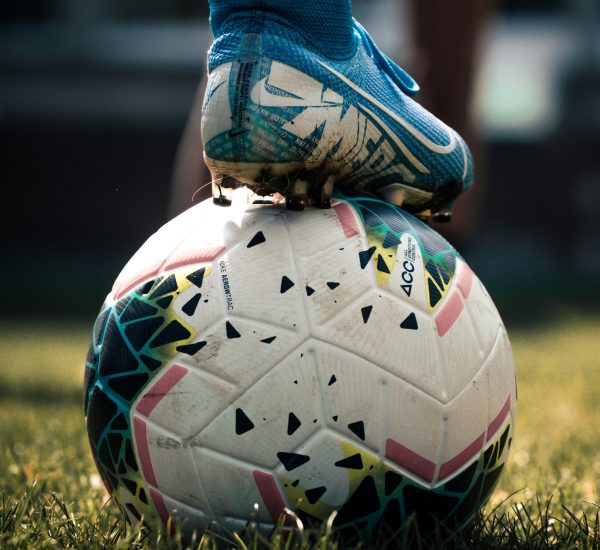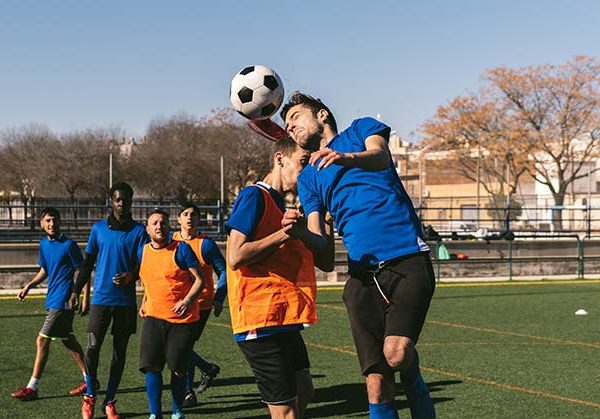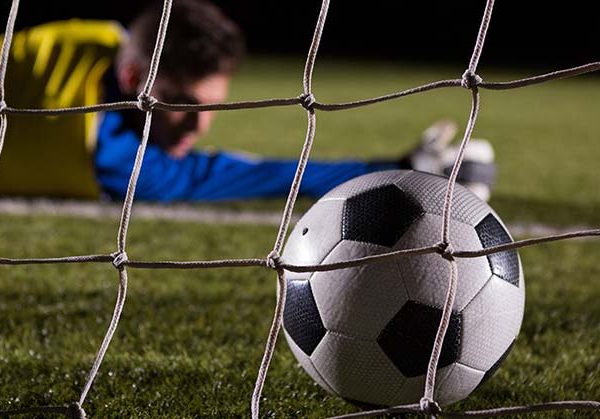Soccer is one of the most popular sports in the world. Though the basic rules are simple, the game is playable in many ways. A critical part of the game is the playing field. The size and shape of the soccer pitch can affect how the game is played.
The size and dimension of a soccer field are essential aspects of the game. The field should be rectangular and be 100-130 yards long and 50-100 yards wide. The penalty area, or “18-yard box”, should be 18 yards wide and 44 yards long. The goal should be 8 feet high and 8 yards wide.
If you are looking to make a soccer field or are just a soccer fan wanting to learn about the size and dimensions of a soccer pitch, then this post will answer all your questions.
Soccer Field Overview
The size of a soccer field is rectangular, measuring 100 yards long by 50 yards wide. Soccer fields are also marked with lines that indicate the boundaries of the playing area.
The playing surface usually is natural grass, although artificial turf is becoming more common. At each end of the soccer field are goal posts, which are 8 feet high and 8 yards wide. The inner edge of the post is equidistant from the touchline, while the outer edge of the post is 18 meters from the touchline.
Soccer Field Surface
When most people think of a soccer field, they imagine a lush, green lawn. However, many different surfaces can be used for a soccer pitch. The two most common surfaces are grass and artificial turf.
The grass is the traditional surface for a soccer field and is used in most professional leagues. It is soft and provides good cushioning for players’ ankles and knees. However, grass can be challenging to maintain and often become muddy after rain or snow.
Artificial turf is an artificial surface made of synthetic materials. It is popular because it is low-maintenance and can be used in all weather conditions. However, some players complain that artificial turf is hard on their joints and causes more injuries than other surfaces.
Soccer Field Markings
There are many different markings on a soccer field. The two prominent markings are the touchlines and the goal lines. The touchlines mark the field’s sidelines, and the goal lines mark where the goals are.
There are also two marks called the penalty areas. The penalty area is marked by a line extending 18 yards from the goal line.
The penalty mark is 12 yards from the goal line, where penalties are taken. Then, finally, there is a center spot where kickoffs and free kicks are taken.
Dimension of the Soccer Field
An understanding of the dimensions of the soccer field is vital for any soccer player or fan. For example, the soccer field’s length is 100 yards, while the width of the soccer field is 50 yards. This dimension will vary from one country to another and from different soccer leagues.
The length of the touchline is usually longer compared to that of the goal line:
Length (touchline):
- minimum 90 m (100 yards)
- maximum 120 m (130 yards)
Length (goal line):
- minimum 45 m (50 yards)
- maximum 90 m (100 yards)
It is to be noted that this dimension applies to domestic leagues. As for international soccer games, FIFA has set other standards. Therefore, the measurement below will vary based on different competitions.
Length (touchline):
- minimum 100 m (110 yards)
- maximum 110 m (120 yards)
Length (goal line):
- minimum 64 m (70 yards)
- maximum 75 m (80 yards)
The Goal Area
The goal area on a soccer field is one of the most critical parts of the game. It is where the goals are scored, and it’s also where the defending team tries to keep the ball from going into the net.
Two lines are drawn at right angles to the goal line, 5.5 meters (6 yards) from the inside of each goalpost. These lines extend into the field of play for 5.5 meters (6 yards) and are joined by a line drawn parallel with the goal line. The region bounded by these lines and the goal line is called the goal area.
The Penalty Area
There is no debating that the penalty area is one of the most crucial soccer field areas. The key to scoring from the penalty area is to ensure you are in a good position and know when and how to take your shot.
The penalty area can be an intimidating place for opponents, but it’s important not to let that intimidate you. You need to stay calm under pressure and know what you are doing to score a goal from this part of the field or to defend your team from attacks.
Two lines are drawn at right angles to the goal line, 16.5 meters (18 yards) from the inside of each goalpost. These lines extend into the field of play for 16.5 meters (18 yards) and are joined by a line drawn parallel with the goal line.
The area bounded by these lines and the goal line is the penalty area.
A penalty mark is made 11 meters (12 yards) from the midpoint between the goalposts within each penalty area.
An arc with a radius of 9.15 meters (10 yards) from the center of each penalty mark is found outside the penalty area.
The Corner Area
The corner area in soccer is one of the most critical aspects of the game. A team needs to control and defend these areas, as they provide crucial opportunities for scoring goals. The size and dimension of a corner area can vary greatly from league to league, depending on the specific rules and regulations that are in place. However, some general guidelines can be followed when constructing a corner area.
When designing a corner area, it is crucial to consider the soccer field’s dimensions. Generally, a corner area markings is a quarter circle with a radius of 1 meter (1 yard) from each corner flagpost drawn inside the field of play.
Additionally, a corner flagpost is a must and must not be less than 1.5 meters (5 feet) high. Furthermore, the lines of the corner area should not be more than 12 cm (5 inches) wide.
The Technical Area
The technical area refers to the spot on a soccer field where team officials, staff, and substitutes stay during soccer games.
Some features of the technical area are listed below:
- the technical area should not be greater than 1 meter (1 yard) on either side of the designated seated area and up to a distance of 1 meter (1 yard) from the touchline
- white color markings are used to define the region that comprises the technical area
- the number of people that are allowed to stay inside the technical area is determined based on the soccer competition being played
- people that are allowed within the technical area are chosen before soccer matches
- anyone within the technical area should behave responsibly
- doctors and physicians are not allowed to move outside the technical area unless they receive the referee’s permission during a player’s injury
- one person at a time can share tactical instruction from the technical area. most of the time, it is the team’s coach
The Goal
There are two goals on each side of a soccer field. They are located in the center of each goal line.
The design of a goal usually consists of two vertical posts of the same distance from the corner flagpost that are joined by a horizontal crossbar. It is recommended that both goals be of the same dimension and shape. It is rectangular in size.
FIFA Quality Programmes for Football Goals recommends that all goals in official competitions under the FIFA regulations meet specific requirements.
The length of the goal is 7.32 meters (8 yards), while the height of the goal is 2.44 meters (8 feet). The dimension of both goals on a soccer field should be the same.
Besides, the goalposts, as well as the crossbar, should be white.
If the crossbar is broken or moves, the referee will stop the game and have it fixed before restarting the soccer match.
Nets are attached at the back of the ball. It is to ensure that the ball has rightfully passed through the goal. The net should not interfere with play and is usually found outside the goal line.
Goal-Line Technology (GLT)
Soccer is a sport that is enjoyed by many around the world. One of the aspects that makes this sport so popular is its use of goal-line technology. This technology allows officials to determine whether a goal has been scored or not, and it has become an essential part of the game.
There are several different types of goal-line technology in use today. The most common is called VAR, which stands for Video Assistant Referee. This system uses footage from several other cameras to help officials decide.
Another goal-line technology is the watch that soccer referees wear. If a goal is scored, vibration will occur on the referee’s watch. This notification is usually instant and indicates that the whole of the ball has passed the goal line. Although the video operating room (VOR) receives footage of the sequence, the referee is usually the only one who is made aware of the result.
Video assistant referee (VAR)
The Video Assistant Referee (VAR) has been introduced in professional soccer worldwide and is set to revolutionize the game. Referred to as “the sixth referee,” VAR is a technological innovation that provides instantaneous video feedback to referees on any potential adjudication related to play.
In its infancy, VAR has had a mixed bag of results, with some clubs preferring it and others not so much. However, with more experience and refinement, VAR can only improve the quality of officiating across all levels of soccer.
The reason for introducing the VAR in soccer is that controversial decisions have led to soccer teams being penalized in the past. The VAR aims to minimalize these errors or even eliminate them in the future.
End of Line
In conclusion, soccer field size and dimension are essential when playing the game. The size of the field and the markings can affect how the game is played and the outcome. Therefore, it is vital to understand the dimensions of a soccer field before playing.



